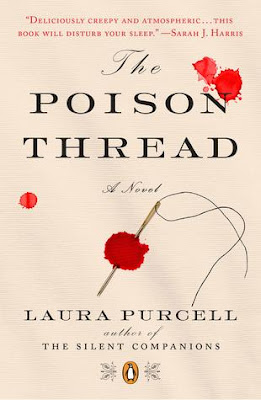 |
| The Poison Thread / Laura Purcell NY: Penguin, c2018 351 p. |
Dorothea Truelove is a young woman who is wealthy, lovely, single, and obsessed with phrenology. She is convinced that the shape of one's head will predict characteristics, particularly criminal tendencies. (I feel like Dorothea would be a true crime podcast fan in our own days) She's not much interested in the men that her father keeps inviting to dinner in order to meet her, being far more focused on her own research.
Ruth Butterham is poor; her father is an artist and her mother takes in sewing. Ruth helps her with sewing, since she seems to have an unnaturally precocious talent for embroidery. In Ruth's exhaustion and bitterness, she focuses on her detail work with great emotional turmoil. And because of this, she comes to believe that her needlework can affect the person wearing it -- that she can injure and even kill from a distance, stitching her intentions into the item she is creating. This kind of sympathetic magic is believable in this Victorian setting, and is unsettling and creepy.
Ruth's life is a miserable one; after her father dies (early on in the book) she is apprenticed out to a dressmaker who turns out to be totally off her rocker. The abuse and terror in this household takes up much of Ruth's story, and is quite visceral and violent -- beware of that if you are not keen on situations of abuse.
But when Ruth ends up in Oakgate Prison, her case interests Dorothea, and their stories begin to converge. Dorothea adds Ruth to the roster of female criminals she is interviewing and examining for head shape. Is Ruth delusional, mad? Or is there something to her story? And do Dorothea's criminal theories hold up? Or are they each simply saying what the other one wants to hear?
For sewists, this story will fascinate for its details on the stitching, embroidering and dressmaking. Ruth makes herself a protective corset (the English title of this book is actually The Corset), and then makes another for her nemesis later on in the book, which is not intended to be protective at all, quite the opposite. The sewing and the precision of description is strong in this book, and the way that Purcell weaves together all the stories is convincing, and creepingly evil.
If you are in the mood for a Victorian gothic replete with fabric and thread, featuring women, betrayal, and mystery, this is the book for you. You should have a higher tolerance for terrible events, though. Definitely a terrifyingly dark read!
I love a good Victorian Gothic and this one sounds particularly appealing. :D
ReplyDeleteIt's quite dark and horrifying, but brilliant too.
DeleteWhat an unusual take on Victorian gothics this must be. I know next to nothing about sewing, but I have to admit that this one intrigues me.
ReplyDeleteIt was the unusual focus on sewing as a plot device that really drew me to this one. But the story is just as strong for a non-sewer ;)
Delete